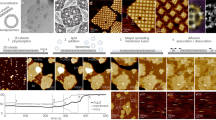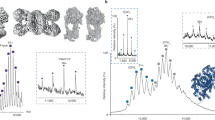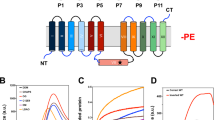Abstract
Schindler et al.1 recently reported lateral diffusion measurements in reconstituted membranes of phospholipid (PL), lipo-polysaccharide (LPS) and Escherichia coli matrix protein (P), using the technique of fluorescence recovery after photobleaching (FRAP). Evaluation of their data led Schindler et al. to conclude that the fluid mosaic model is an inadequate description of the membrane and to propose a new membrane model. Their conclusion was based on identifying the fluid mosaic model with a particular binding behaviour of LPS to matrix protein. I present here a more general model for the association of membrane components, and demonstrate the use of lateral diffusion data in elucidating membrane structure. The data of Schindler et al. are shown to be reasonably interpretable on the basis of an association of LPS and matrix protein, which obviates the necessity for postulating a new membrane model.
This is a preview of subscription content, access via your institution
Access options
Subscribe to this journal
Receive 51 print issues and online access
$199.00 per year
only $3.90 per issue
Buy this article
- Purchase on Springer Link
- Instant access to full article PDF
Prices may be subject to local taxes which are calculated during checkout
Similar content being viewed by others
References
Schindler, M., Osborn, M. J. & Koppel, D. E. Nature 283, 346–350 (1980).
Schindler, H. & Rosenbusch, J. P. Proc. natn. Acad. Sci. U.S.A. 75, 3751–3755 (1978).
Author information
Authors and Affiliations
Rights and permissions
About this article
Cite this article
Jähnig, F. No need for a new membrane model. Nature 289, 694–696 (1981). https://doi.org/10.1038/289694a0
Received:
Accepted:
Issue Date:
DOI: https://doi.org/10.1038/289694a0
Comments
By submitting a comment you agree to abide by our Terms and Community Guidelines. If you find something abusive or that does not comply with our terms or guidelines please flag it as inappropriate.



